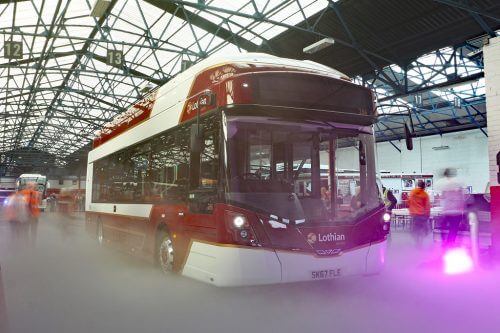
Six Wrightbus StreetAir electrics, valued at £2.7m, enter operation on Service 1
Lothian Buses has launched a fleet of six new fully electric vehicles.
At an investment of over £2.7m, the new Wrightbus StreetAir single-deckers began operation on Lothian Buses Service 1 from Monday, October 2. The service runs through Edinburgh’s central air quality management area.
The vehicles can carry up to 70 passengers and are fitted with WiFi, high-back seats, USB charging points and LED spotlights. They operate on a pure electric powertrain, including an all-electric heating and cooling system, with 300kWh of total battery energy.
The buses will charge overnight at new charging stations installed within Lothian’s Annandale Street garage. Once plugged in, the vehicles are fully charged in three-four hours and can operate for up to 130 miles on electric power. They are designed with regenerative braking, allowing the energy created when the vehicle is braking to be recovered back to the batteries to extend the range of the bus.
Lothian said it will be adding a further five electric vehicles to the service next year.
Humza Yousaf, Scottish Transport Minister, said: “I am delighted to join Lothian in the launch of its new electric buses. It is fantastic to see operators, like Lothian, investing in its fleet in a way that supports both their passengers and the environment through new low carbon and electric vehicles.”
Richard Hall, Managing Director of Lothian, added: “We fully support the Scottish Government and City of Edinburgh Council’s strategies to improve local air quality. The introduction of full electric buses to this route, combined with our on-going fleet replacement strategy ‘BUS2020’, ensures that we as a business are doing our part to improve air quality across the city.
“These buses are not only fitted with zero emission technology, they are also quieter and smoother, offering a better customer experience for the thousands of customers who travel with us every day.
“Electric Bus technology is here and we need to embrace it and ensure that it is part of our future fleet and business planning strategies, it absolutely has a place alongside traditional diesel and hybrid technologies.”

